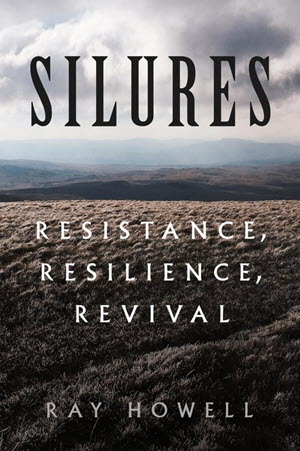Silures
 Back in issue #50 I ran a review of a small book called Celtic Wales, written by two very eminent historians who are experts on the country during the Iron Age. I found that book by chance in the local history section of Swansea Waterstones. As I happened to be back in the shop recently I had another look in that section to see if they had anything else. I was immediately rewarded.
Back in issue #50 I ran a review of a small book called Celtic Wales, written by two very eminent historians who are experts on the country during the Iron Age. I found that book by chance in the local history section of Swansea Waterstones. As I happened to be back in the shop recently I had another look in that section to see if they had anything else. I was immediately rewarded.
Silures: Resistance, Resilience, Revival, is a solo effort by Professor Ray Howell, and he’s probably the world expert on that particular group of ancient Welsh people. That’s Silures, not Silurians. The Silurians are lizard people named after the Silurian geologic period, which was in turn named after rocks first identified in the part of Wales that the Silures inhabited.
So who were the Silures? According to the Romans, they were a tribal grouping that occupied south-east Wales prior to the invasion. In modern terms their territory was Glamorgan and Gwent. My home is at the eastern end of the territory of a different tribal group, the Demetae.
Following the Claudian invasion, the British war leader, Caractacus (I’m using the Roman version of name for ease of look-up) found sanctuary among the Silures. After a defeat in a close-fought battle he fled north where we was betrayed by Queen Cartimandua of the Brigantes (sorry Nicola, Yorkshire women were a bit sus in those days). The Silures, however, kept on fighting. It took 25 years of warfare for the Romans to finally subdue them, and even then peace was only achieved by offering the Silures a degree of self-rule. They became a civitas, with their own senedd at Venta Silurum (Caerwent).
While Celtic Wales is very much a contribution to an academic debate, Silures is much more of a popular history book. Professor Howell doesn’t even use his academic title, and his style is very conversational. He reminisces about his occasional appearances on Time Team, and openly speculates in ways that he could never do in an academic volume. His style is very engaging and I found myself wishing that I’d had him as a lecturer.
The purpose of the book is to shine more of a light on this fascinating group of ancient Welsh people who thoroughly terrified the Romans. Tacitus wrote that neither atrocity nor clemency had any effect on them, they were resolutely opposed to Rome. But, being Welsh, they are very little studied by the archaeological establishment in the UK. Howell notes that, of over 50 known Silurian hill forts in Gwent alone, only 3 have been professionally excavated since WWII.
So what do we know about them? We know that they were very warlike. We know that they loved horses (well, Welsh ponies) and would have used chariots. And we know that they lived in roundhouses and built an impressive number of hillforts. Howell notes that these formed a social network: each hillfort was in line of sight view of at least one other. Of course the term “hillfort” is a bit of misnomer as they probably served as much as a civic hub as a defensive position. They were not, like Norman castles, intended to dominate the local population, but rather provided it with various services and a sense of identity.
Howell, being from south Wales himself, likens the hillfort network to the fact that every village has its own rugby club. And our fiercest rivalries are probably with the people from the next valley over, unless those red-crested soldiers (or red roses on white uniforms) are spotted, in which case we immediately unite against the common enemy.
Of course, over a few hundred years, the enemy does not always stay the enemy. One of the best stories in the book concerns a high status Roman burial from around the end of the second century CE that Howell was called in to investigate after a builder’s digger cut through the coffin. Isotope analysis of the teeth showed that this man was a local, born and raised in Silurian territory. But he was clearly very wealthy and presumably well thought of in Roman society. A facial reconstruction was commissioned, and a photo appears in the book. Even before I read the accompanying text, I had immediately jumped to the same conclusion: this was a face I have seen in a rugby shirt.

Title: Silures
By: Ray Howell
Publisher: The History Press
Purchase links:
Amazon UK
Amazon US
Bookshop.org UK
See here for information about buying books though Salon Futura